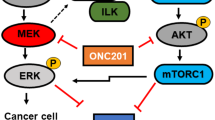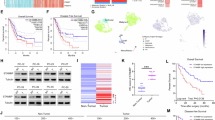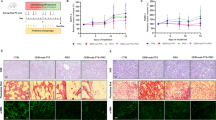Abstract
Survival is one of the most important endpoints in cancer therapy, and parametric survival analysis could comprehensively reveal the overall result of disease progression, drug efficacy, toxicity as well as their interactions. In this study we investigated the efficacy and toxicity of dexamethasone (DEX) combined with gemcitabine (GEM) in pancreatic cancer xenograft. Nude mice bearing SW1990 pancreatic cancer cells derived tumor were treated with DEX (4 mg/kg, i.g.) and GEM (15 mg/kg, i.v.) alone or in combination repeatedly (QD, Q3D, Q7D) until the death of animal or the end of study. Tumor volumes and net body weight (NBW) were assessed every other day. Taking NBW as a systemic safety indicator, an integrated pharmacokinetic/pharmacodynamic (PK/PD) model was developed to quantitatively describe the impact of tumor size and systemic safety on animal survival. The PK/PD models with time course data for tumor size and NBW were established, respectively, in a sequential manner; a parametric time-to-event (TTE) model was also developed based on the longitudinal PK/PD models to describe the survival results of the SW1990 tumor-bearing mice. These models were evaluated and externally validated. Only the mice with good tumor growth inhibition and relatively stable NBW had an improved survival result after DEX and GEM combination therapy, and the simulations based on the parametric TTE model showed that NBW played more important role in animals’ survival compared with tumor size. The established model in this study demonstrates that tumor size was not always the most important reason for cancer-related death, and parametric survival analysis together with safety issues was also important in the evaluation of oncology therapies in preclinical studies.
Similar content being viewed by others
Log in or create a free account to read this content
Gain free access to this article, as well as selected content from this journal and more on nature.com
or
References
Baracos VE, Martin L, Korc M, Guttridge DC, Fearon KCH. Cancer-associated cachexia. Nat Rev Dis Prim. 2018;4:17105.
Jung J, Seol HS, Chang S. The generation and application of patient-derived Xenograft model for cancer research. Cancer Res Treat. 2018;50:1–10.
Al-Huniti N, Feng Y, Yu JJ, Lu Z, Nagase M, Zhou D, et al. Tumor growth dynamic modeling in oncology drug development and regulatory approval: past, present, and future opportunities. CPT Pharmacometrics Syst Pharmacol. 2020;9:419–27.
Kamat AM, Sylvester RJ, Böhle A, Palou J, Lamm DL, Brausi M, et al. Definitions, end points, and clinical trial designs for non-muscle-invasive bladder cancer: recommendations from the International Bladder Cancer Group. J Clin Oncol: Off J Am Soc Clin Oncol. 2016;34:1935–44.
Xie F, De Clercq K, Vervaet C, Van Bocxlaer J, Colin P, Vermeulen A. Model-based analysis of treatment effects of paclitaxel microspheres in a microscopic peritoneal carcinomatosis model in mice. Pharmacol Res. 2019;36:127.
George B, Seals S, Aban I. Survival analysis and regression models. J Nucl Cardiol. 2014;21:686–94.
Schober P, Vetter TR. Survival analysis and interpretation of time-to-event data: the tortoise and the hare. Anesth Analg. 2018;127:792–8.
Brilleman SL, Crowther MJ, Moreno-Betancur M, Buros Novik J, Dunyak J, Al-Huniti N, et al. Joint longitudinal and time-to-event models for multilevel hierarchical data. Stat Methods Med Res. 2019;28:3502–15.
Hansson EK, Amantea MA, Westwood P, Milligan PA, Houk BE, French J, et al. PKPD modeling of VEGF, sVEGFR-2, sVEGFR-3, and sKIT as predictors of tumor dynamics and overall survival following sunitinib treatment in GIST. CPT Pharmacometrics Syst Pharmacol. 2013;2:e84.
Krishnan SM, Friberg LE, Bruno R, Beyer U, Jin JY, Karlsson MO. Multistate model for pharmacometric analyses of overall survival in HER2-negative breast cancer patients treated with docetaxel. CPT Pharmacometrics Syst Pharmacol. 2021;10:1255–66.
Vagnildhaug OM, Blum D, Wilcock A, Fayers P, Strasser F, Baracos VE, et al. The applicability of a weight loss grading system in cancer cachexia: a longitudinal analysis. J Cachexia Sarcopenia Muscle. 2017;8:789–97.
Tang J, Zhang J, Liu Y, Liao Q, Huang J, Geng Z, et al. Lung squamous cell carcinoma cells express non-canonically glycosylated IgG that activates integrin-FAK signaling. Cancer Lett. 2018;430:148–59.
Biswas AK, Acharyya S. Understanding cachexia in the context of metastatic progression. Nat Rev Cancer. 2020;20:274–84.
Yao Y, Yao QY, Xue JS, Tian XY, An QM, Cui LX, et al. Dexamethasone inhibits pancreatic tumor growth in preclinical models: Involvement of activating glucocorticoid receptor. Toxicol Appl Pharmacol. 2020;401:115118.
Braun TP, Grossberg AJ, Krasnow SM, Levasseur PR, Szumowski M, Zhu XX, et al. Cancer- and endotoxin-induced cachexia require intact glucocorticoid signaling in skeletal muscle. FASEB J. 2013;27:3572–82.
Schakman O, Gilson H, Thissen JP. Mechanisms of glucocorticoid-induced myopathy. J Endocrinol. 2008;197:1–10.
Siddiqui JA, Pothuraju R, Jain M, Batra SK, Nasser MW. Advances in cancer cachexia: Intersection between affected organs, mediators, and pharmacological interventions. Biochim Biophys Acta Rev Cancer. 2020;1873:188359.
Wang LJ, Li J, Hao FR, Yuan Y, Li JY, Lu W, et al. Dexamethasone suppresses the growth of human non-small cell lung cancer via inducing estrogen sulfotransferase and inactivating estrogen. Acta Pharmacol Sin. 2016;37:845–56.
Yuan Y, Zhou X, Ren Y, Zhou S, Wang L, Ji S, et al. Semi-mechanism-based pharmacokinetic/pharmacodynamic model for the combination use of dexamethasone and gemcitabine in breast cancer. J Pharm Sci. 2015;104:4399–408.
Tomayko MM, Reynolds CP. Determination of subcutaneous tumor size in athymic (nude) mice. Cancer Chemother Pharmacol. 1989;24:148–54.
Yuan Y, Zhou X, Li J, Ye S, Ji X, Li L, et al. Development and validation of a highly sensitive LC-MS/MS method for the determination of dexamethasone in nude mice plasma and its application to a pharmacokinetic study. Biomed Chromatogr. 2015;29:578–83.
Koch G, Walz A, Lahu G, Schropp J. Modeling of tumor growth and anticancer effects of combination therapy. J Pharmacokinet Pharmacodyn. 2009;36:179–97.
Yao Y, Yao Q, Fu Y, Tian X, An Q, Yang L, et al. Pharmacokinetic/Pharmacodynamic modeling of the anti-cancer effect of dexamethasone in pancreatic cancer xenografts and anticipation of human efficacious doses. J Pharm Sci. 2020;109:1169–77.
Schmidt SF, Rohm M, Herzig S, Berriel, Diaz M. Cancer Cachexia: more than skeletal muscle wasting. Trends Cancer. 2018;4:849–60.
Wilson MK, Karakasis K, Oza AM. Outcomes and endpoints in trials of cancer treatment: the past, present, and future. Lancet Oncol. 2015;16:e32–42.
Zhu AZ. Quantitative translational modeling to facilitate preclinical to clinical efficacy & toxicity translation in oncology. Future Sci OA. 2018;4:Fso306.
Lu Z, Fang Y, Liu C, Zhang X, Xin X, He Y, et al. Early Interdisciplinary supportive care in patients with previously untreated metastatic esophagogastric cancer: a Phase III randomized controlled trial. J Clin Oncol. 2021;39:748–56.
Christodoulou I, Ho WJ, Marple A, Ravich JW, Tam A, Rahnama R, et al. Engineering CAR-NK cells to secrete IL-15 sustains their anti-AML functionality but is associated with systemic toxicities. J Immunother Cancer. 2021;9:e003894.
Dalal S, Hui D, Bidaut L, Lem K, Del Fabbro E, Crane C, et al. Relationships among body mass index, longitudinal body composition alterations, and survival in patients with locally advanced pancreatic cancer receiving chemoradiation: a pilot study. J Pain Symptom Manag. 2012;44:181–91.
Talbert EE, Cuitiño MC, Ladner KJ, Rajasekerea PV, Siebert M, Shakya R, et al. Modeling human cancer-induced Cachexia. Cell Rep. 2019;28:1612–1622.e1614.
Leggas M, Kuo KL, Robert F, Cloud G, deShazo M, Zhang R, et al. Intensive anti-inflammatory therapy with dexamethasone in patients with non-small cell lung cancer: effect on chemotherapy toxicity and efficacy. Cancer Chemother Pharmacol. 2009;63:731–43.
Iwasaki S, Hamada T, Chisaki I, Andou T, Sano N, Furuta A, et al. Mechanism-based pharmacokinetic/pharmacodynamic modeling of the glucagon-like peptide-1 receptor agonist exenatide to characterize its antiobesity effects in diet-induced obese mice. J Pharmacol Exp Ther. 2017;362:441–9.
Holford N. A time to event tutorial for pharmacometricians. CPT Pharmacometrics Syst Pharmacol. 2013;2:e43.
Bose S, Le A. Glucose metabolism in cancer. Adv Exp Med Biol. 2018;1063:3–12.
Acknowledgements
The study was supported by Peking University Medicine Seed Fund for Interdisciplinary Research (Approval No. BMU2021MX003).
Author information
Authors and Affiliations
Contributions
TYZ and QYY designed research; QYY, YCG, WZJ and RWZ performed research; QYY, JZ, YY and JSX analyzed the data; QYY, JZ, TYZ and XYQ wrote and revised the manuscript.
Corresponding authors
Ethics declarations
Competing interests
The authors declare no competing interests.
Supplementary information
Rights and permissions
Springer Nature or its licensor holds exclusive rights to this article under a publishing agreement with the author(s) or other rightsholder(s); author self-archiving of the accepted manuscript version of this article is solely governed by the terms of such publishing agreement and applicable law.
About this article
Cite this article
Yao, Qy., Zhou, J., Yao, Y. et al. An integrated PK/PD model investigating the impact of tumor size and systemic safety on animal survival in SW1990 pancreatic cancer xenograft. Acta Pharmacol Sin 44, 465–474 (2023). https://doi.org/10.1038/s41401-022-00960-0
Received:
Accepted:
Published:
Issue date:
DOI: https://doi.org/10.1038/s41401-022-00960-0



